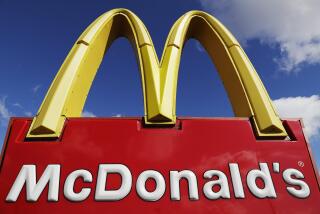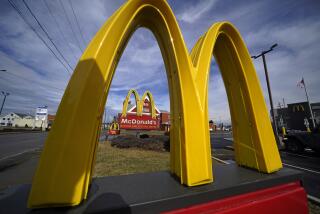Tomatoes are back on menus
Tomatoes are making a comeback in Southern California and most of the nation, though the source of the salmonella outbreak that has sickened at least 383 people remains a mystery.
McDonald’s Corp. said Wednesday that it would reintroduce sliced tomatoes in its U.S. restaurants over the next seven to 10 days, and some markets in the Los Angeles area, including Vons and Fresh & Easy, have begun stocking produce sections with Roma, plum and red round tomatoes grown in areas deemed safe by the Food and Drug Administration.
Yum Brands Inc., which owns the KFC, Pizza Hut and Taco Bell chains, said it started resupplying its restaurants Monday. Fresh salsa is reappearing at El Pollo Loco Inc. outlets, which a spokeswoman said had begun accepting shipments of FDA-approved tomatoes Friday night.
Consumers were happy the fruit was back -- or nervous about its return.
“I’m going to wait a week before I buy tomatoes,” said Juan Negrete, 53, a security guard from Echo Park, as he ordered lunch at a McDonald’s. “I usually eat a salad once or twice a day, but now I’m scared.”
The Centers for Disease Control and Prevention raised the number of victims by 106 on Wednesday, citing a recent surge in reports from several states. But the key dates of outbreak haven’t changed: The first person fell ill April 10 and the last, so far as officials know, on June 5. At least 48 people have been hospitalized.
“We have to say that the outbreak is ongoing,” Robert Tauxe, the CDC’s deputy director of the division of foodborne, bacterial and mycotic diseases, said on a conference call Wednesday. “It’s really too early to call the peak. We certainly cannot say it’s over.”
The search for the source is continuing, with officials focusing on parts of Mexico as well as southern and central Florida.
The FDA has ruled out crops in California and 38 other states, along with several counties in northern Florida and the District of Columbia.
“We may not ultimately know the farm where these [tainted tomatoes] came from,” David Acheson, the FDA’s associate commissioner for foods, said in an interview. “Personally, I’m optimistic, but I’m trying to be realistic.”
Acheson wouldn’t say whether the FDA’s most promising lead -- a cluster of nine cases connected to one chain of restaurants in a single unidentified area -- is the same as the group of nine people that the Chicago Department of Public Health said were sickened by salmonella after eating at an Adobo Grill.
“For a tomato trace-back, this is going very quickly,” Acheson said. “They’re really hard to track -- it’s a spider’s web of suppliers and distributors.”
Unlike bags of spinach or jars of peanut butter, products linked to recent health scares, individual tomatoes don’t have bar codes, making tracking difficult.
Many growers and retailers have expressed frustration over the duration of the investigation, and some consumers said they weren’t happy with the federal government either.
“It was a crazy reaction to the problem,” said Henry Lowenfels, 26, an independent film producer from Echo Park who was shopping Wednesday at a Vons in Hollywood.
The self-described “tomato guy” said he was irritated that his favorite fruit had disappeared from shelves for so long, but added: “If it were to happen again, then I’d be worried” about the safety of tomatoes.
This is the country’s 13th salmonella outbreak linked to tomatoes since 1990, according to officials.
The FDA posted its advisory June 7, warning that fresh Roma, plum and red round tomatoes were at risk.
Big supermarket chains and fast-food conglomerates took no chances, removing the fruit from shelves and menus and destroying tomatoes being kept in reserve. Many consumers avoided tomatoes altogether.
Supermarkets such as Vons said they made up the difference with the cherry, grape and vine-attached tomatoes that were cleared by the FDA.
“There really was no time when we had no tomatoes,” said Teena Massingill, a spokeswoman for Safeway Inc., which owns Vons. “Once we pulled the affected products, we filled those spaces with product that had been approved.”
Farmers were hit hard. In Florida, the nation’s top tomato producer, experts estimated that more than $40 million of the fruit was destroyed.
In a letter Tuesday to the U.S. Department of Health and Human Services, the United Fresh Produce Assn. said the outbreak undercut consumer confidence and could cost the national tomato industry more than $100 million.
With a 25-pound box of U.S. tomatoes selling for about $15 on the East Coast and a box of Mexican tomatoes going for $8 to $10 in California, domestic producers were feeling the pressure to drop their prices, Ed Beckman, president of the California Tomato Farmers cooperative, said in an e-mail.
Several buyers switched permanently last week from California tomatoes to Canadian tomatoes over distrust of and confusion about which growing regions had been cleared by the FDA, Beckman said.
“Situations like these continue to evolve,” he said. “It’s too early to say what the true economic impact is.”
He predicted it would take a week for stores and restaurants to be fully resupplied with tomatoes.
Most tomatoes are absent from Ralphs shelves, chain spokesman Terry O’Neil said.
The supermarket chain pulled the three affected varieties June 8 and has returned a limited supply in certain stores of large red round tomatoes grown in Canadian hothouses. Romas are expected back on shelves in the next few days, and all other varieties of tomatoes have been ordered, O’Neil said.
Most grocery stores and restaurants have posted signs detailing the origins of the tomatoes now being sold.
At Vons, Massingill said Roma tomato shipments were accompanied by certificates that the fruit was from areas including California, Canada and approved counties in Florida. Beginning next week, stores will receive tomatoes from Baja California, Massingill said.
“There’s no indication yet that there’ll be a long-term effect from the outbreak, and if there is, it’ll be seen throughout the industry,” she said. “But if there’s any way to make tracking and safety better, I’m sure we would implement it here.”
--
conor.sanchez@latimes.com
More to Read
Inside the business of entertainment
The Wide Shot brings you news, analysis and insights on everything from streaming wars to production — and what it all means for the future.
You may occasionally receive promotional content from the Los Angeles Times.











